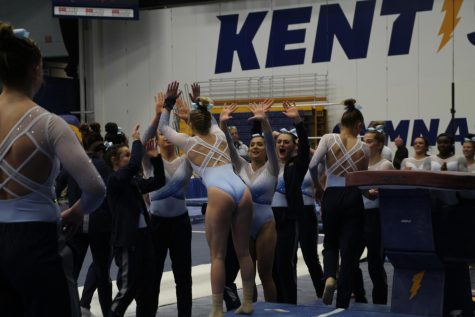Empty seats plague KSU women’s athletics
Senior forward Jordan Korinek drives to the hoop for two of her career-high 36 points against Bowling Green on Jan. 31, 2018. Kent State won the game, 81-57. [FILE]
February 28, 2018
Everytime the Kent State women’s basketball team steps onto the court, they do so ready to play their hearts out.
But once the horn sounds and tip-off happens, the student section isn’t full, and the crowd isn’t as roucous as they would be for a men’s game.
“No lie, the men get more fans, but you know I expect that because they’re men,” said junior Merissa Barber-Smith, a center for the women’s basketball team.
Generally, Kent State’s women’s sports programs tend to bring in less attendance numbers than some of the male collegiate sports.
The NCAA 2016-17 attendance numbers shows an average of 524 attendants over 14 home games for women’s basketball. The men’s team have averaged a total of 2,879 attendants over 16 home games.
These numbers are not only consistent with basketball, but low attendance is prevalent in women’s softball, volleyball and soccer as well.
Morgan Toles, a women’s basketball assistant coach, sees this as a problem and said men usually always get a significant more amount of student attendance.
“They get more of attendance from the students themselves compared to women where it’s usually just family, friends and usually an older crowd,” Toles said.
The women’s sports tend to bring in a different demographic of audience members. Many who have become fans because of the team’s relationship building with members of the community.
“We’re definitely thankful for the support that we get,” Toles said. “I think in the back of our minds, you know, you see the men’s game and you’ll see the student section is completely just packed and we don’t get a lot of that student support.”
The women’s basketball team found supportive fans by volunteering at churches and schools.
“We do lots of different things and we always let them know, ‘Hey, come out to our game, please be very supportive, and it’s very fun.’ And usually, when we go to the schools, we let the kids know, ‘Hey, do you want to see a women’s game?’” Barber-Smith said.
Aaron Chimenti, an assistant director of Athletic Communications, said Kent State gymnastics is one of the most attended women’s sports because of years of established relationships with youth groups and gymnastics clubs in the area.
“Traditionally, they’ve been a very good program,” Chimenti said. “Almost every season, they’ve either won the MAC season or the MAC championships.”
Chimenti said the formula for many collegiate programs is both developing community relationships and also success during games.
“When I first came here in the 2005-06 season, it was kind of an end of an era where women’s basketball was really successful, so the crowds there were bigger than most of the women’s basketball crowds we’ve seen in recent years,” Chimenti said.
In 2002, the women’s basketball team made the NCAA Tournament and, while doing so, sparked a lot of excitement with fans that led to higher attendance numbers.
Casey Cegles, the deputy athletic director of external operations, also believes success often correlates with increased attendance.
“I’ve been highly involved with ticketing and ask anybody and anyone can tell you winning is a big deal as far as attendance goes, that’s not just specific to men or women I think it’s any program,” Cegles said.
Other collegiate Mid-American-Conference athletic programs have also experienced similar trends.
“I think out of all the MAC schools … we have pretty good attendance numbers with students to all of our events, and for us, I think that’s a good step to have with students here,” Cegles said.
Cegles also mentioned the school’s overall traditions play a factor as well.
“If you look at women’s basketball at University of Connecticut and their men’s basketball, both have historically terrific programs,” Cegles said. “The women come close to selling out 15,000 for every women’s game out there, and that’s just because they win and they have a great tradition that’s just kind of engrained.”
Both Chimenti and Cegles said Kent State Athletics works to try to increase engagement and overall student participation.
“We’re always trying to figure out what makes our fans come out. Is it the free T-shirts? Is it the free food? Is it the sports that they’re watching? Is it the timing of the event? All these things play a factor,” Cegles said.
The athletic department does not know the reason behind the difference in audience engagement between men’s and women’s sports.
“As far as men and women’s games, why some people come to one and not the other, that’s stuff we’re trying to figure out each and every day with our students and with our fanbase,” Cegles said. “If we can figure out, OK, this is what’s making them come, then what else can we do to attract more people.”
Chimenti said the difference could be based on social factors.
“I think with some events there’s a social element to it,” Chimenti said. “‘I’m going because my friends are going, and we’re going to have a good time whether we pay attention to the game or not.’ I think we have a little bit of that with football and (men’s) basketball, and you can get that from time to time in our other sports too.”
Football and basketball are not only socially based, but Cegles said the sports bring in the most revenue.
“There’s more demand so we might market more for football or for men’s basketball,” Cegles said. “It’s kind of a return on investment kind of thing.”
This return on investment also leads to higher marketing of the most popular sports.
“I can tell you we market for all of our programs,” Cegles said. “I know for a fact that we do put more money behind some programs.”
Barber said she hopes things will change in the future.
“I hope it does (change), but I’m not sure,” Barber-Smith said. “It takes a lot to make a change and this has been going on for so long.”
Faith Riggs is the women and gender issues reporter. Contact her at [email protected].






















